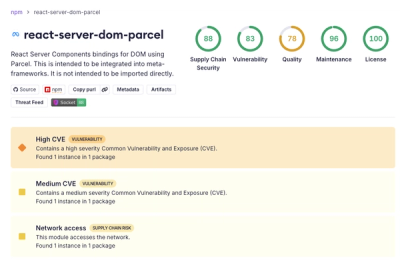
Security News
Deno 2.6 + Socket: Supply Chain Defense In Your CLI
Deno 2.6 introduces deno audit with a new --socket flag that plugs directly into Socket to bring supply chain security checks into the Deno CLI.
gridengine-framework
Advanced tools
grid_engine is a framework for generating and manipulating grids. It provides a number of classes and functions for generating and manipulating grids. Each grid is composed of Cell objects and is defined by a Blueprint. A grid can be generated from a blueprint, loaded from a file, or created manually. It can also be pickled for later use. It can be rendered as a 2D image, an animated GIF or an ASCII string. Grids provide a number of relevant methods for pathfinding, cell manipulation, and more.
To install grid_engine, run the following command:
```bash
pip install gridengine_framework
```
To use gridengine you can import any number of the submodules and utilize its respective features or you can import the main module.
```python
import grid_engine as ge
# Create a grid
grid = ge.grid.Grid(cell_size=10, grid_dimensions=(1000, 1000))
# Save a grid
ge.grid.save_grid(grid)
# Load a grid
loaded_grid = ge.grid.Grid.load_grid(1)
```
grid_engine also provides a command line interface. To use it, run the following command:
```bash
python -m grid_engine --help
# Output:
# usage: gridengine [-h] [-i] [-b BLUEPRINT] [--ascii] [-l LOAD] [-t] [-ns NOISE_SCALE] [-no NOISE_OCTAVES] [-nr NOISE_ROUGHNESS] [-r ROWS] [-c COLUMNS] [-s SIZE] [-S] [-T TYPE] [-v]
# Generate a visualized grid from a blueprint. For producing a blueprint, see the blueprint module.
# options:
# -h, --help show this help message and exit
# -i, --interactive Run an interactive session
# -b BLUEPRINT, --blueprint BLUEPRINT
# Load a blueprint from a file
# --ascii Print the grid as ascii
# -l LOAD, --load LOAD Load a grid from a file
# -t, --terrain Whether to generate terrain with the grid.
# -ns NOISE_SCALE, --noise-scale NOISE_SCALE
# Noise scale
# -no NOISE_OCTAVES, --noise-octaves NOISE_OCTAVES
# Noise octaves
# -nr NOISE_ROUGHNESS, --noise-roughness NOISE_ROUGHNESS
# Noise roughness
# -r ROWS, --rows ROWS Number of rows in the grid
# -c COLUMNS, --columns COLUMNS
# Number of columns in the grid
# -s SIZE, --size SIZE Size of each cell in the grid
# -S, --save Save the grid object to a file
# -T TYPE, --type TYPE Type of file to save the grid as
# -v, --verbose Verbose output
```
The following examples demonstrate the use of the grid_engine package.
The following command:
```bash
python -m grid_engine -v -S -t -ns 400 -no 75 -nr 0.55 -r 450 -c 800 -s 2
```
Will produce the following output:
```bash
Generating blueprint with cell size 2, 450 rows and 800 columns. Total_cells: 360000 ...
Success! Blueprint generated. Dimensions: (1600, 900)
Building grid from blueprint ...
Finding landmasses ...
Separating islands from landmasses ...
done
Finding start to river ...
Found largest landmass: 0 with 302951 cells
Finding lake coastal cells ...
Found 1094 cells.
Validating start/end of river ...
Start cell: pd00229(445, 228), End cell: dq00087(146, 86))
Building river ...
Getting river cells by walk ...
Generating river with end designated ...
Cells in river: 300 | Current cell: kb00082 | Next cell: kc00082
River steps: 300
Found largest landmass: 0 with 302951 cells
Finding lake coastal cells ...
Found 1094 cells.
Validating start/end of river ...
Start cell: ip00499(275, 498), End cell: dv00087(151, 86)
Building river ...
Getting river cells by walk ...
Generating river with end designated ...
Cells in river: 757 | Current cell: dz00082 | Next cell: ea000814
River steps: 757
done
Success! Grid generated.
Pickling grid ...
Success!
Pickling blueprint ...
Success!
Generating grid image ...
Importing pillow ...
Preparing raw image ...
Counting cells ...
Total cells: 360000
Shuffling cells ...
Cells drawn. 100%
Saving grid image ...
Grid ID: 8d564
```
The following image is the result of the above command:

The river generation algorithm is not perfect. I am currently working on improving it.
The above command will also produce the following files(Not included in the repository... That is, generate your own!):
grid.cf1b9.pickle: A pickled Grid object.
blueprint.cf1b9.pickle: A pickled TerrainGridBlueprint object.
import grid_engine
from grid_engine import Grid
# Load the 8d564 grid(assuming you've not generated any other grids)
_8d564 = Grid.load_grid('8d564')
print(_8d564.grid_id)
# output: 'fb16965aa77f44138dd6149b823ee9e4'
# Get a random cell
cellA = _8d564.random_cell(attr=('passable', True))
# Get another
cellB = _8d564.random_cell(attr=('passable', True))
# Get a path from cellA to cellB
path, cost = _8d564.get_path(cellA, cellB)
print(path)
FAQs
A framework for generating and manipulating grid-based game worlds
We found that gridengine-framework demonstrated a healthy version release cadence and project activity because the last version was released less than a year ago. It has 1 open source maintainer collaborating on the project.
Did you know?

Socket for GitHub automatically highlights issues in each pull request and monitors the health of all your open source dependencies. Discover the contents of your packages and block harmful activity before you install or update your dependencies.

Security News
Deno 2.6 introduces deno audit with a new --socket flag that plugs directly into Socket to bring supply chain security checks into the Deno CLI.

Security News
New DoS and source code exposure bugs in React Server Components and Next.js: what’s affected and how to update safely.

Security News
Socket CEO Feross Aboukhadijeh joins Software Engineering Daily to discuss modern software supply chain attacks and rising AI-driven security risks.